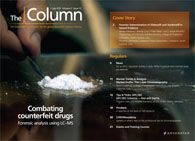Forensic Determination of Sildenafil and Vardenafil in Seized Evidence
Forensic Determination of Sildenafil and Vardenafil in Seized Evidence
A plastic-wrapped bundle of herbs packaged and sent halfway around the world. A cardboard box filled with blister-packaged counterfeit tablets. A bag of coffee. One‑half tablet, either cut or bitten. A single open capsule with only a residue of powder remaining. These are just a few of the samples that have been seized by law enforcement agencies, analysed by forensic chemists and identified as containing illegally‑distributed sildenafil, the active ingredient in Viagra.
The illegal use and abuse of prescription drugs has surged in recent years and poses a challenge to forensic laboratories around the world. The Internet, along with an increasingly complex global supply chain, has led to their widespread illegal distribution. This is especially true for so-called “lifestyle” drugs such as Viagra, Levitra and Cialis, all of which are phosphodisesterase-5 (PDE-5) inhibitors used to treat erectile dysfunction (ED). These medications and the Internet became increasingly popular in the late 1990s and have been linked ever since. In October 2008, an Internet search engine found 13 million hits for “Buy Viagra.” In March 2011, the same search resulted in 33 million hits.
Whether it is due to convenience, expedience or embarrassment, men who suffer from ED often choose Internet pharmacies to purchase these medications without a prescription. Others buy them online not for therapeutic purposes, but for recreational use, including dangerous combinations of the PDE-5 inhibitor with 3,4-methylenedioxymethamphetamine (more commonly known as MDMA or ecstasy) in a club drug known by such colourful names as “sextasy,” “trail mix“ or “hammerheading” (so-called due to its headache-inducing side effects). As early as 1999, one year after Viagra’s market introduction, use of the drug in combination with ecstasy was reported in Canada, the US and the UK. Some products advertised as “all-natural” have been found to be mixed with sildenafil, thus unknowingly exposing the customer to the PDE-5 inhibitor — a serious public health problem, as this class of drugs is contraindicated for a number of other prescription medications. In 2009, 900 boxes of coffee laced with sildenafil were confiscated in Malaysia. That same year, herbal supplements sold in stores throughout the UK were pulled from the shelves after the country’s Medications and Healthcare Regulatory Agency (MHRA) found the capsules not only contained tadalafil but that the drug was present at more than twice the maximum allowable dose for a prescribed tablet.
Separating Impurities from Oligonucleotides Using Supercritical Fluid Chromatography
February 21st 2025Supercritical fluid chromatography (SFC) has been optimized for the analysis of 5-, 10-, 15-, and 18-mer oligonucleotides (ONs) and evaluated for its effectiveness in separating impurities from ONs.

.png&w=3840&q=75)

.png&w=3840&q=75)



.png&w=3840&q=75)



.png&w=3840&q=75)











